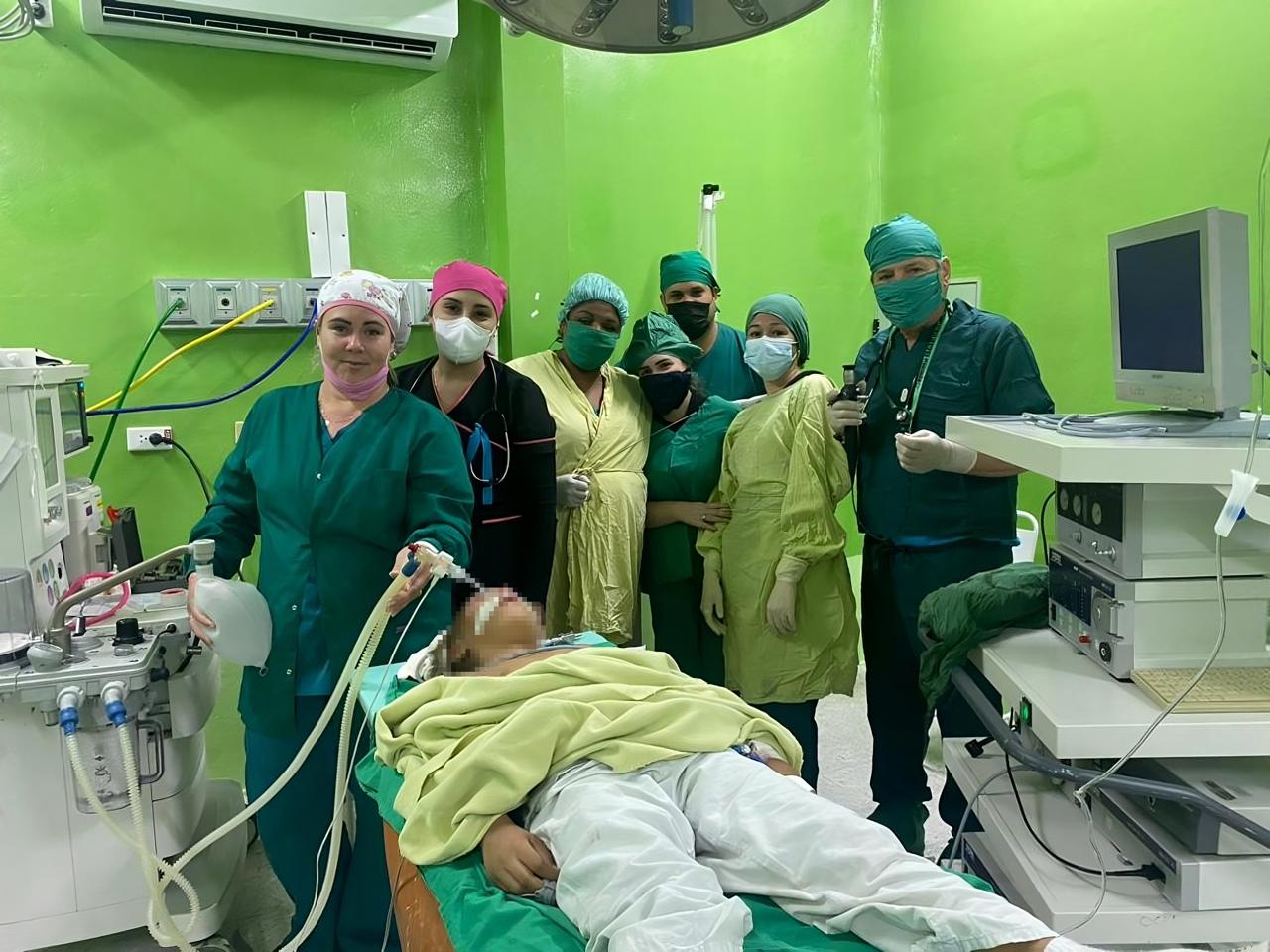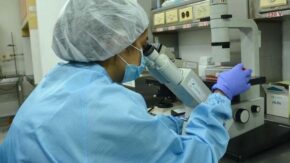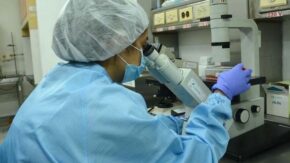From anxiety to hope


It was December 19 and the spirit of Christmas flooded the house of Caridad Elena Blanca González, a skilled doctor with 33 years of experience in Pediatric Otolaryngology who, in the middle of preparing for Christmas Eve dinner, received the most dreaded of calls: a child had accidentally swallowed a piece of watch and was in grave danger. There was no time to lose, and friends and celebrations were behind them.
“We were called in desperation because an infant had been referred from the municipality of Trinidad, after having swallowed a piece of watch that had been placed in his mouth and accidentally aspirated,” says the specialist.
The little boy, only seven years old, arrived at the hospital with respiratory manifestations such as coughing, although, according to Dr. Gonzalez, he appeared to be in good health and seemed to be calm before the storm. She, who has seen it all, as they say in good Cuban, knows that in a short time the vital functions of children can collapse. The situation was critical, a surgical emergency in the purest sense.
“The child had compromised oxygen saturation due to the deprivation of ventilation of the right lung where the foreign body was lodged,” Blanca Gonzalez explains.
The tension rose when the doctors discovered that the patient already had a previous diagnosis of laryngitis, which made every second count even more: “In other words, there was already a respiratory compromise that aggravated the situation and this was the scenario in which the child came to us,” she says.
THE PROCEDURE
In a matter of minutes, Dr. Caridad and her team prepared for a procedure that was literally a race against time and death. The only hope was a risky technique that defies the expertise of even the most experienced physicians.
The procedure usually used in the pediatric hospital is rigid bronchoscopy, that is to say, a rigid tube with which the lung is accessed through the same route through which the foreign body entered: “We usually enter through the mouth to reach the larynx, the trachea, the main or intermediate bronchi, which was the case of this patient,” he adds.
The scene in the operating room was tense, with each team member fully aware of what was at stake. In other words, in this type of technique, ventilation cannot be guaranteed and it becomes a race for life. To give you a clearer idea, the procedure is performed in a situation of apnea, i.e., oxygen deprivation for the patient.
In any other type of surgery, the anesthesiologist places a tube in the child’s airway that will ensure breathing through the use of specialized machines, but, in this type of case, it is impossible to guarantee such a vital function because the specialist must make his way through the same space through which the endotracheal tube is placed.
“The child is practically in respiratory arrest and the anesthesiologists almost always assist him through the ventilation channel of the equipment with which we have access; but what this practically offers is 25% oxygen, which does not guarantee the child’s survival.
“We try to do the procedure as quickly as possible because oxygen deprivation leads to bradycardia and cardiorespiratory arrest leading to death. We have seen this, unfortunately, and I can assure you that it is heartbreaking,” the doctor confesses.
The fact of having a foreign body lodged in a lung is a critical element and if to this is added, in addition, that the patient had an infectious inflammatory condition of the airway, it practically forced the specialists to remove the piece at the first attempt or there would be no solution, because the mucosa of the airway is hyper-reactive and responds inflammatorily when it is manipulated.
The team combined devices and expertise: first, guided by a pulmonologist, they used a flexible bronchoscope to locate the part. Then, with the rigid bronchoscope, they advanced “blindly” into the right lung.
In general, the foreign body is first located by the pulmonologists, who do have the vision to do so, but then it is my turn to remove it, which I do with my own vision because we do not have more advanced instruments in the province. To tell the truth, it is a procedure feared both by our specialty and by the anesthesiologists,” he says.
To make matters worse, when the doctor gained access to the interior of the respiratory tract, she noticed that it was not only laryngitis, but also laryngotracheitis, which meant that the entire trachea presented an inflammatory condition.
THE JOY OF A HAPPY ENDING
With surgical precision and nerves of steel, Dr. Gonzalez and her team performed the procedure. Every second seemed like an eternity. Finally, they completed the removal of the foreign body successfully on the first attempt and in less than 60 seconds: “Completing the mission gives us indescribable joy, especially when you have worked with patients who have not succeeded”.
“I have to say that I really felt insecure because I knew how risky this case was and especially in the scenario of bringing a base laryngotrachitis, but before the surgery we asked God to help us and that is how the miracle came out,” said Dr. Gonzalez.
What is the most difficult thing about this type of experience?
“When there is an obstruction of the airway, we are in the presence of a medical emergency, that is to say, a critical situation, and although I have more than 30 years of experience in dealing with situations of this type, it is always an immense fright”.
“When the surgery is over and you know that you can give the news that everything went well, you feel on cloud nine, but on other occasions we have had to go out and tell the parents that their child did not make it or that it was us, the doctors, who did not make it, and that is something very painful”.
“No specialist wants his or her patient to die and, when it is a child, it is doubly painful because by natural thought it is not theirs and a family can be destroyed; you know that there is always a father and a mother with the hope that their child will leave the room alive and when you have to look them in the eyes and tell them that it was not possible, that pain tears your soul apart,” the specialist in Pediatric Otolaryngology points out.
RISKS AND MIRACLES: WE CRIED TEARS OF JOY
Joy and relief filled the operating room when the little patient returned to normal breathing. The story was not only an example of medical expertise, but also a testament to the courage and dedication of a team willing to fight for every life until the last breath.
The child was monitored for 48 hours in the Intensive Care Unit of the José Martí Pediatric Hospital in Sancti Spíritus, where he showed remarkable improvement. Then he was discharged and his parents, visibly moved, did not stop thanking the medical team, as Ailyn Cruz Guinaga, a first degree specialist in Anesthesiology and Resuscitation, tells us.
The greatest danger was atelectasis (lung collapse) or that the piece would move and lacerate tissues. “We monitored every heartbeat and every drop of oxygen. If the parameters dropped, we had to withdraw and reintubate,” he explains. But the miracle came and the piece came out on the first try. “The whole team cried. The children’s health is the most important thing for us,” the specialist says.
The boy, stable after surgery, revealed an innocent truth: “He wanted to repair his grandfather’s little clock and this almost cost him his life,” says Dr. Cruz Guinaga, adding that his parents, in tears, signed an informed consent form minutes before the procedure. “We explained to them the risks, from cardiac arrest to irreversible damage. No parent wants to see their child in the operating room.”
Behind every medical emergency, there are faces, decisions and seconds that make a difference. In the case of this Trinidadian child, Dr. Ailyn, with 12 years of experience, was one of the professionals who held the thread of hope in her hands: “At all times, oxygenation, heart rate, as well as the hemodynamic status of the patient are monitored and we assess whether there is a need to remove the instrument and recover the patient so that oxygenation is at optimal levels.
“But, in addition, the positive pressures that one gives in the airway can move the foreign body out of place, although, of course, this depends on the size,” he says.
With six similar cases attended to in her career, the anesthesiologist makes an urgent appeal: “Adult supervision is vital while children play at home. These accidents are preventable. And, although she acknowledged the fear she felt – “my heart went up in my throat”-, she celebrates the happy ending: “This child returned home on Christmas Eve. That gives us back our faith in what we do.



